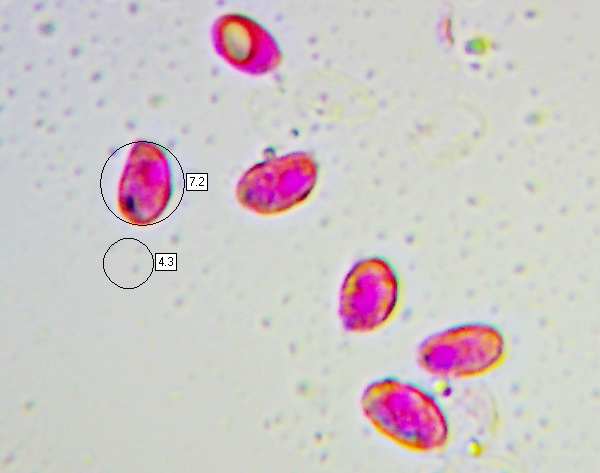Mycena rosea (Bull.) Gramberg - Rosy Bonnet
Phylum: Basidiomycota - Class: Agaricomycetes - Order: Agaricales - Family: Mycenaceae
Distribution - Taxonomic History - Etymology - Identification - Toxicity - Reference Sources
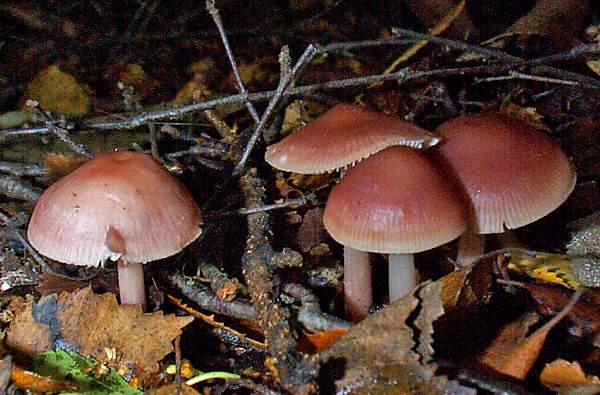
The Rosy Bonnet, Mycena rosea, a larger relative of the Lilac Bonnet, Mycena pura, appears in leaf litter usually beneath deciduous trees. This is a poisonous species and should not be collected for food; it contains the dangerous toxin muscarine.
Like many other species in the genus Mycena, the Rosy Bonnet is reported to be bioluminescent, emitting a weak green light (wavelength in the region of of 520 to 530 nanometres).
Although generally considered fungi of broadleaf woodland, Rosy Bonnets are also fairly common in coniferous forests on acidic soil, where they often form picturesque groups or lines close to tree trunks.
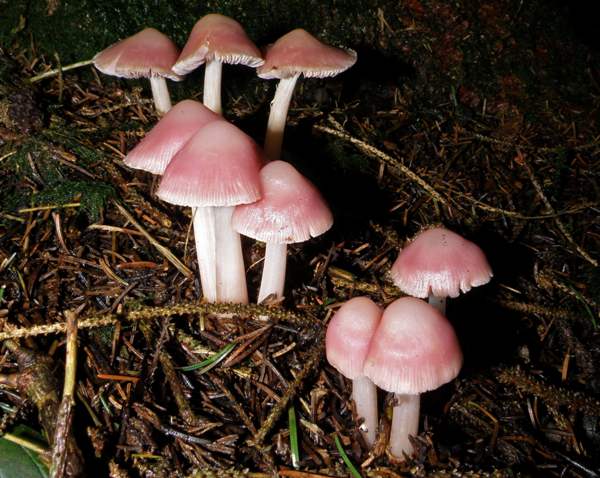
Distribution
Less common and more localised than the very similar but typically smaller yellow-to-lilac-capped Mycena pura, which is commonly known as the Lilac Bonnet, Mycena rosea is found throughout Britain and Ireland as well as in many parts of northern and central mainland Europe. Just as Mycena pura occurs in North America, so also do pure pink bonnet mushrooms which correspond macroscopically and microscopically to the formal description of Mycena rosea; however, in the USA not all mycologists accept that these are two separate species, although there is some evidence that the toxic chemicals in the two are not quite the same.
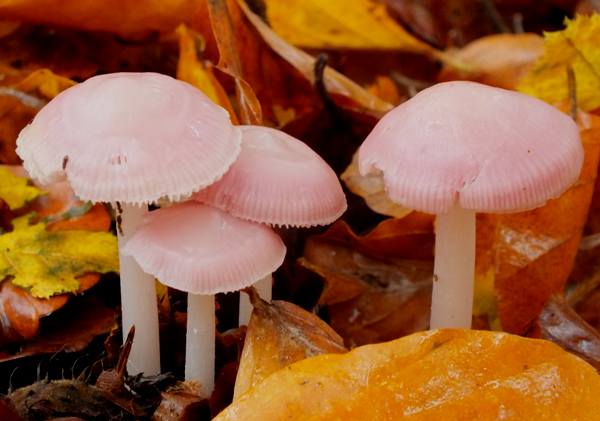
Taxonomic history
The basionym of this species was defined when, in 1783, Jean Baptiste Francois (Pierre) Bulliard described this species and gave it the name Agaricus roseus. (Most of the gilled mushrooms were included initially in the genus Agaricus!)
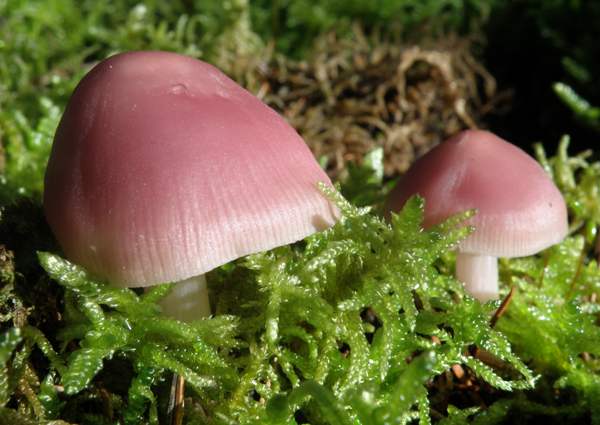
The currently-accepted scientific name of the Rosy Bonnet dates from 1912, when Prussian-born mycologist Eugen Gramberg (1865 - 1945) transferred this woodland mushroom to the genus Mycena, thus making its scientific name Mycena rosea.
Synonyms of Mycena rosea include Agaricus roseus Bull., Agaricus purus a roseus (Bull.) Pers., Mycena pura f. rosea (Bull.) J. E. Lange, and Mycena pura var. rosea (Bull.) J. E. Lange.
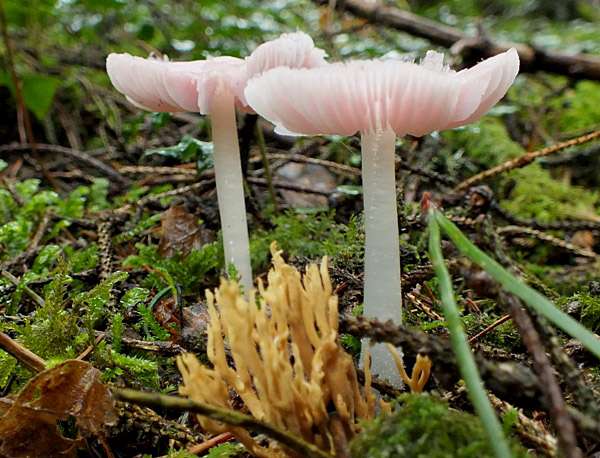
Etymology
The specific epithet rosea comes from Latin and means rosy or pink.
The beautiful Rosy Bonnet mushrooms shown on the left were photographed in the Lot Valley in France. They look delicious, but sadly these are toxic toadstools (see below).
Identification guide
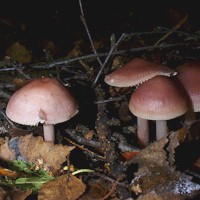 |
Often persisting until the first frosts of winter, Mycena rosea is a very attractive bonnet mushroom and is most commonly found beneath beech trees and on roadside verges bordered by beech hedges, but I have found this species also in spruce plantations. |
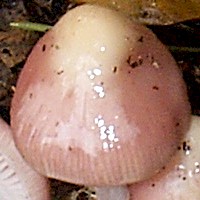 |
Cap2 to 6cm in diameter, the caps of Mycena rosea are more bell-shaped and rather larger than those of the closely related species Mycena pura. The hydrophanous caps vary in colour from almost white to a deep pink, becoming paler with age and when desiccated. |
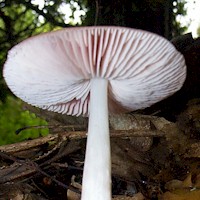 |
GillsPallid pink and crowded, the broad gills are deeply sinuate. |
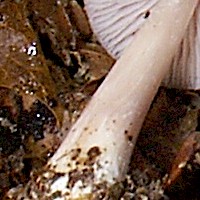 |
StemWhite or pale pink, smooth with longitudinal fibres, the hollow stem tapers only slightly towards the apex. There is no stem ring. The base of the stem is slightly downy where it enters the leaf litter. |
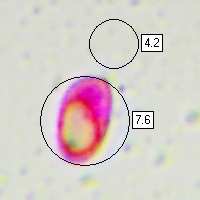 |
SporesEllipsoidal, smooth, 7-9 x 4-5.5μm. Spore printWhite. |
Odour/taste |
When crushed, this bonnet mushroom smells strongly of radish; it also has a radish taste. |
Habitat & Ecological role |
Saprobic, among leaf litter in deciduous woods and mixed woodland. |
Season |
August to November in Britain and Ireland. |
Similar species |
Mycena pura is usually slightly smaller and has a lilac (or occasionally yellowish-grey) cap with a central umbo; its spores are smaller. Some mycologists still treat these as two varieties of the same species. |
Toxicity
Mycena rosea looks innocent enough, but it contains the deadly toxin muscarine, albeit in low concentrations; it must therefore be considered inedible and potentially poisonous. Do not eat these toadstools!
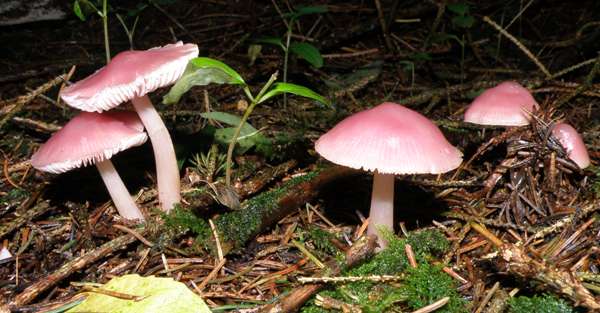
Reference Sources
Fascinated by Fungi, 2nd Edition, Pat O'Reilly 2016, reprinted by Coch-y-bonddu Books in 2022.
Penny Cullington, (Oct. 2013). British Mycenas - Brief Descriptions.
Giovanni Robich, (2003). Mycena d'Europa; Associazione Micologica Bresadola ; Vicenza : Fondazione Centro Studi Micologici.
British Mycological Society. English Names for Fungi
Dictionary of the Fungi; Paul M. Kirk, Paul F. Cannon, David W. Minter and J. A. Stalpers; CABI, 2008
Taxonomic history and synonym information on these pages is drawn from many sources but in particular from the British Mycological Society's GB Checklist of Fungi.
Fascinated by Fungi. Back by popular demand, Pat O'Reilly's best-selling 450-page hardback book is available now. The latest second edition was republished with a sparkling new cover design in September 2022 by Coch-y-Bonddu Books. Full details and copies are available from the publisher's online bookshop...
